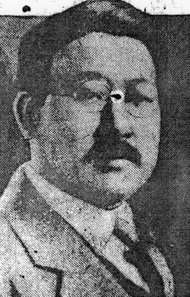Yasuo Matsui
| Yasuo Matsui | |
|---|---|
 Yasuo Matsui in 1930 | |
| Born |
1877 Japan |
| Died | 1962 |
| Nationality | Japanese-American |
| Alma mater | University of California, MIT[1] |
| Occupation | Architect |
| Practice | F.H. Dewey & Company |
| Buildings | 40 Wall Street, Empire State Building, Starrett-Lehigh Building |
Yasuo Matsui (1877 – 1962) was a prominent 20th century Japanese American architect.[2]
Early years
Immigrating from Japan to the United States in 1902, Matsui attended the University of California and afterward worked for Ernest Flagg. He was one of the architects who worked on the Empire State Building.[3] He eventually rose to the position of President at F.H. Dewey & Company, an architectural firm, which was involved with many prominent skyscraper projects on the East Coast. Their most prominent project was the 71-story 40 Wall Street building.[4] He also designed the Japanese Pavilion at the 1939 World's Fair.[5]
World War II
Along with other prominent Japanese living throughout the United States, Matsui was arrested by the FBI after the bombing of Pearl Harbor. He was taken to Ellis Island on December 8, 1941 and interned for two months until he was paroled in February 1942.[6] For the rest of the war his freedom to travel was curtailed, he had to report his activities to the federal government every month, and he was barred from owning a camera. He was released from parole in October 1945.[2]
Death
He died a naturalized American citizen in 1962. He left a married daughter.[2]
Bibliography
- Matsui, Yasuo (1930-03-01). "Architect Explains Tower Height: finds observatory still among highest of skyscrapers standing today" (PDF). Fultonhistory.com. Retrieved 2015-06-10.
See also
References
- ↑ Bascomb, Neal (2003) Higher: A Historic Race to the Sky and the Making of a City New York: Doubleday, p. 86
- 1 2 3 Gray, Christopher (2012) A Towering Career; a Collision With War in The New York Times. (Accessed: 11 February 2017)
- ↑ Larry Tajiri cited in Pacific Citizens: Larry and Guyo Tajiri and Japanese American Journalism in the World War II Era edited by Greg Robinson (Urbana-Champaign: University of Illinois Press, 2012), 34.
- ↑ "The Manhattan Company". skyscraper.org. Retrieved 3 July 2016.
- ↑ Wood, A.F. (2004) New York’s 1939-1940 World’s Fair (postcard history series). Charleston, SC: Arcadia Publishing SC. ISBN 978-0738535852 (Accessed: 10 February 2017)
- ↑ Larry Tajiri cited in Pacific Citizens: Larry and Guyo Tajiri and Japanese American Journalism in the World War II Era edited by Greg Robinson (Urbana-Champaign: University of Illinois Press, 2012), p. 34.